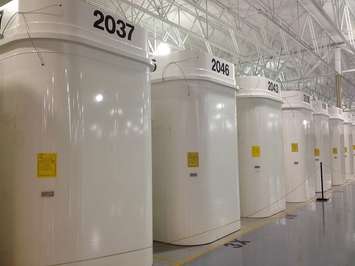According to the Nuclear Waste Management Organization, (NWMO) updates to the Confidence in Safety Report for the proposed South Bruce Deep Geological Repository for Canada’s used nuclear fuel show the facility can be safely constructed at the proposed Saugeen Ojibway Nation (SON)-South Bruce site.
The NWMO's technical subject matter expert, Paul Gierszewski, explained the fundamental safety objective of the project is to protect humans and the environment, including water, from the effects of radioactive or hazardous substances.
Previous discussions and studies have identified the Revell Site (Ignace) in northwestern Ontario and the South Bruce Site in southern Ontario as candidate repository sites. Municipalities, First Nations and Metis communities in both siting areas are working with the NWMO as part of the site selection process.
Gierszewski pointed out further scientific studies have been added to the safety report which was originally published in 2022. Gierszewski said a closer look at the location 10 km south of Highway 9 shows it is a good site for the proposed South Bruce deep geological repository. He said they have looked at site-specific geological information for the first time.
" A 400-m thick succession of low-permeability Ordovician-aged sedimentary rocks that are 444-460 million years old, are present beneath the South Bruce site, including the approximately 40 m thick Cobourg Formation at a depth of about 650 m, bounded above by more than 200 m of shale and below by more than 150 m of limestone and argillaceous (clay-bearing) limestone," the report stated. Gierszewski stressed the natural barrier system has the depth, breadth, and volume to isolate the repository from surface disturbances and changes caused by human activities and natural events.
"This report now has results from chemistry and hydraulic testing at the site itself that confirms the strong hydraulic barrier over the repository that would protect surface watersheds," revealed Gierszewski. "What we're seeing is the signs of the chemistry, for example, and properties of the rock that make it that barrier. And that's what's been added in this report, those sites specific measurements of chemistry and water transmissivity properties."
According to the report, the NWMO is confident that a repository located in the Cobourg Formation, located about 650 m below the surface at the South Bruce Site, will allow for safe repository construction and operation, and that the used nuclear fuel will remain isolated from the surface and near-surface environment for sufficiently long times.
He added the engineering design of the repository has been advanced to confirm the underground layout fits within the site. And further study confirmed no active geological features.
"It's a seismically quiet site and we'd be confirming that," Gierszewski proclaimed. "In fact, we've been adding these additional micro seismic stations so we can really listen to even very small movements, really tiny things, that tell us more about geology and the stability. They're not there for seismic risk as much as for understanding geology. It is a good site seismically."
The report showed the South Bruce Site is located in a stable, seismically quiet setting overlying Precambrian rocks of the Canadian Shield at the heart of the North American continent, far from tectonic plate boundaries and is therefore not prone to large earthquakes and recent volcanic activity. Gierszewski added that researchers looked at chemistry properties of the rock and water transmissivity.
"When you get down to depth. We're talking about water in the pores of the rock," disclosed Gierszewski. "So there's like one per cent porosity in the rock. When you look at it as rock, you don't see water but when you measure it, you can squeeze out that water and you can measure its property. So that water is very saline, which tells us that it's very old."
However, he clarified that is one of the issues that will require more study.
"There are a number of things that we want to continue to understand better," he outlined. "The salinity itself is good as it's a good sign of the geology, but we have to do more studies on that. And also when you're designing the engineered system, you have to make sure you use the materials that were designed to work in the saline water system. So it's important for us to know."
The report also stated there is no indication that the South Bruce Site location will experience extreme rates of erosion, uplift or subsidence that would significantly perturb the geosphere over the next million years.
The NWMO is also considering a site in Ignace, Ontario, with a decision expected by the end of the year.
"This year there's a site selection decision between them and of course both communities are making their assessments of willingness and by their own processes," explained Gierszewksi. "Then at the end of the year, we anticipate that we choose a preferred site and then we just start into more detailed characterization. So this is a point in process. There's more studies to be done at the site. And then there's a whole multi year licensing process."
Further site specific properties are needed to finalize the design. This includes rock properties, as well as details of the surface and near-surface environment, such as hydrology.
South Bruce residents are expected to have their say on hosting the site. In 2021, an independent consultant gathered public feedback on how the South Bruce community wanted to measure its willingness to be a host, and then Council voted that willingness should be decided by public referendum.
Gierszewski noted a preliminary site-based safety assessment indicates that there would be no impacts on human health during normal operations or post-closure.
" I think this report gives them confidence that the site is a good site, and we could proceed with the repository at this site and keep everybody safe," concluded Gierszewski.
The NWMO said the site would be monitored for decades during site characterization, preparation, construction and operation, before a decision is made to close the repository. Further information on the report can be found here.
Canada's used nuclear fuel is currently stored in the NWMO's above ground facility at the Bruce Nuclear Power site.






